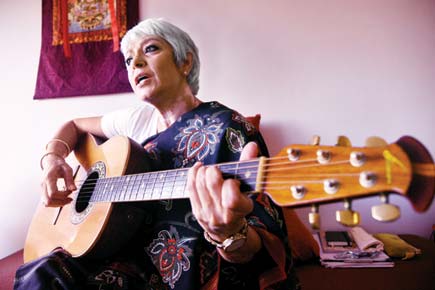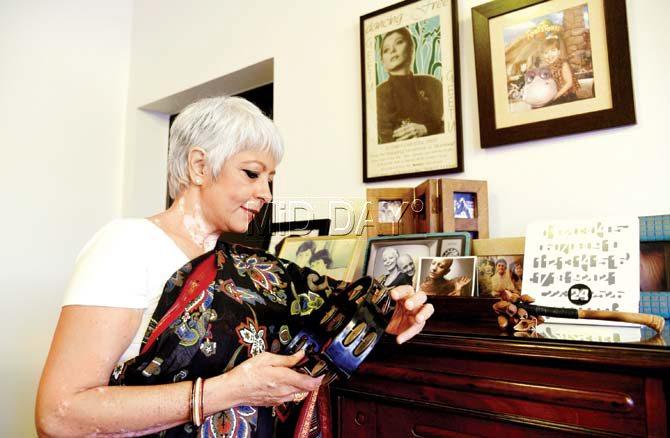Singer-songwriter Geetu Hinduja discusses new album It’s About Time

![]() How often have you seen a sari-clad woman at 56 holding a guitar and playing a set of her originals in a setting thronged by youngsters? It may sound new to many readers but for singer-songwriter Geetu Hinduja, the practice started in the early 90s. When we met her at her Bandra home, she pointed to a glamorous, Meryl Streep-like photograph hung on the wall — her first album cover (Dancing Free) that released in 1993. Come September, she is all set to release her third album titled It’s About Time.
How often have you seen a sari-clad woman at 56 holding a guitar and playing a set of her originals in a setting thronged by youngsters? It may sound new to many readers but for singer-songwriter Geetu Hinduja, the practice started in the early 90s. When we met her at her Bandra home, she pointed to a glamorous, Meryl Streep-like photograph hung on the wall — her first album cover (Dancing Free) that released in 1993. Come September, she is all set to release her third album titled It’s About Time.
ADVERTISEMENT

Geetu Hinduja’s jam room at her Bandra residence carries old photographs on the wall. Pics/Suresh Karkera
“The sound of the first album was a mixture of Pop and Jazz. I wasn’t that good with Jazz but musician Dinshah Sanjana, along with wife Sandhya, helped me with production. The city had a vibrant Jazz scene then,” says Hinduja, sitting in her jam room that overlooks the Arabian Sea. The space — with an Ovation guitar, tambourine, books and photographs of her daughters — encompasses her journey as musician, art curator, sovereign woman and mother.

The sound of hope
Her second album Hope Faith, Time & Me came in 2012. It was dedicated to her sister’s fight with cancer. Talking about the 19-year gap between the two records, Hinduja says, “My kids were young, and I wasn’t the independent woman I am today. So I went back to my shell and didn’t know how to take this step forward. I think I was still finding myself. It seemed a challenge to pursue music at the time. I started an art business when my youngest was 10 in 1998. It seemed more acceptable for a mother of three. I lived in a joint family,” she smiles. In 2009, her matchless voice and pleasing-to-the-eye appearance at a concert in Bandra Fort strew flowers and lilies. She only wanted to shed the accumulated rust with a gig but what followed was an album. “I didn’t want an album. But I hung out with musicians, wrote songs and one fine day, there was an album. I just wanted to do a concert but I thought we live just once, so I decided to quit the art business in 2014 to come back to music,” adds Hinduja, who once had an art gallery. The album, arranged and produced by Prasad Ruparel, spoke about her identity. “The instruments used were of my choice. It was a contemporary, Folk-Fusion kind of a sound,” she says.
A new beginning
Hinduja’s Renaissance (through the comeback gig) happened at 50. “I think it was the right age, holding the first big concert at 50 was special,” she says. However, her sudden emergence with a guitar and grey hair raised eyebrows.
“People were intrigued by the notion of me suddenly deciding to be a musician. Many commented, ‘Oh! You sing? We can sing too’. But not many knew that I kept studying music throughout these years. I still do online courses in songwriting and guitar playing. The album came from the questions thrown at me,” adds Hinduja, who also collaborated with a gang of women for a single called Sisterhood. Apart from Hinduja, the group involves Vasuda Sharma, Alisha Pais, Vivienne Pocha, Mynah Marie, Naama Choonawala, Nandini Shankar and Shubangi Joshi. The single will release along with the album.
Album talk
The graceful lady experimented with electronic music in a couple of songs and the rest is her signature sound — Folk ballads. Like the earlier one, this album also has a shloka talking about the time aspect of Shiva. The song Feel The Sun talks about evolving as a person. “You have to feel the sun inside yourself,” says Hinduja. Nonetheless, the pick of the album could be It's Time To Move On, the groove of which is inspired from Sade’s Smooth Operator.
Her songs are a reflection of her journey, travel diaries and experiences across the world. “I have travelled a lot. Actually, I learnt professionalism by playing gigs in Europe. There, you send e-mails and get immediate responses. In India, it is doubtful whether you will get an answer. Maybe they will reply; maybe they will worship you, maybe they will ignore you. The world would have been easier had people been more direct,” says Hinduja, who believes she learnt a lot about music through art and spending time with artists.
 Subscribe today by clicking the link and stay updated with the latest news!" Click here!
Subscribe today by clicking the link and stay updated with the latest news!" Click here!






